Resistive Microwires
The resistive microwires are based on alloys used for the manufacturing of precise resistors.
The main requirements for resistive microwires are:
- close to zero temperature coefficient of resistance (TCR), in the operating temperature range;
- high long-time stability of resistivity;
- low thermal EMF in pairing with copper;
- high stability of resistivity after the impact of extreme environmental temperatures, both high and low;
- stability in a variety of production environments – humidity, acids and alkalis, other aggressive factors.
Examples of resistive alloys for microwires:
|
Alloy |
Chemical composition |
Resistivity Ohm*mm2/m |
Range of linear resistance kOhm/m |
TCR Grad-1 |
Temperature range, С |
|
Manganin |
Cu-Ni-Mn-Si |
0,45 - 0,5 |
1,5 - 50 |
±10*10-6 |
- 20 ÷ +90 |
|
DN(ДН)-1 |
Cu-Ni-Mn-Si |
0,5 - 0,6 |
1,5 - 50 |
±5*10-6 |
- 60 ÷ +120 |
|
Alloy C(Ц) |
Ni-Mn-Cr-Si |
1,4 – 1,5 |
5 - 250 |
±1*10-6 |
- 60 ÷ +280 |
|
70 NHS(НХС) |
Ni-Cr-Si |
1,6 – 1,7 |
50 - 800 |
±1*10-6 |
- 60 ÷ +280 |
Magnetic Microwires
The new breakthrough in applications of microwires evolved due to the research results of unique magnetic properties observed in microwires with amorphous and microcrystalline structure of microwire’s core.
Microwires with positive, negative or zero magnetostriction can be produced using alloys with carefully controlled composition.
Axial, radial and tangential stresses, and also the value and sign of magnetostriction are forming a wide variety of magnetic structures and magnetic properties.
At positive magnetostriction (iron based alloys), the direction of magnetostatic and magnetoelastic anisotropy and direction of easy magnetization coincide with the axis of the microwire. Such microwire has the property of bistability. Its re-magnetization occurs with a great single Barkhausen jump:
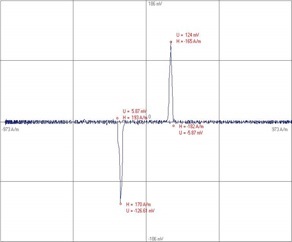
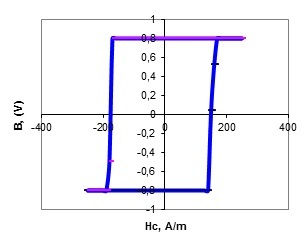
Pulse of remagnetization and hysteresis loop of bistable micrwore
With negative magnetostriction (in cobalt based alloys), the magnetoelastic anisotropy creates an axis of easy magnetization which is directed perpendicular to the axis of the microwire. In a longitudinal magnetic field, such microwires are re-magnetized with the rotation of magnetization vector. The hysteresis loop has an inclined shape with very small coercive force (anhysteretic remagnetization).
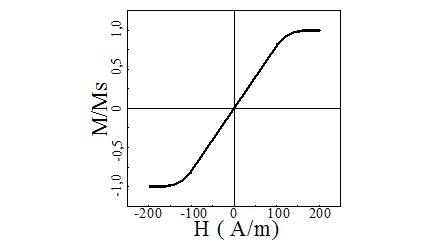
Anhysteresis loop of remagnetization for microwires with negative magnetostriction
In microwires with close to zero (small negative) magnetostriction, complex magnetic structures appear: “circular” or “helicoidal”, with surficial closure domains.
In such microwires, very high values of magnetic permeability (up to 1,000,000) and magnetic impedance at high frequencies (up to 800%) are achieved.
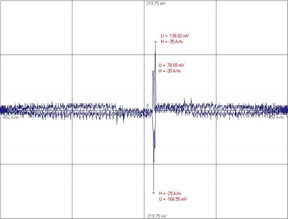

Pulse of remagnetization and hysteresis loop of microwire with small negative magnetostriction
Stress sensing microwires
(microwires that are sensitive to mechanical stress)
Being subjected to a special thermomechanical treatment, the microwire changes its magnetization characteristics, e.g. a rectangular hysteresis loop, usual for a bistable microwire, becomes inclined.
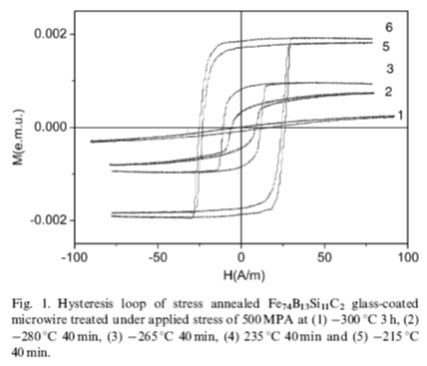
Hysteresis loop of microwire, with positive magnetostriction, applied TMT (tension 500 MPa, (1) 300 ºС, 3 hour; (2) 280 ºС, 40 min.; (3) 265 ºС, 40 min.; (4) 235 ºС, 40 min.; (5) 215 ºС, 40 min.;)
By applying tensile stress to such microwires, the opposite phase transition occurs: the inclined loop transforms to a rectangular one, as in the original microwires.
The values of magnetic permeability, coercive force and pulse amplitude change 50-100 times under the influence of a tensile stress.
Supersensitive sensors of stresses, displacements, stress sensitive composite materials can be made on the basis of such microwires.
